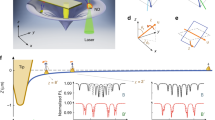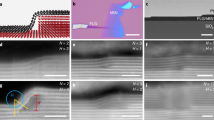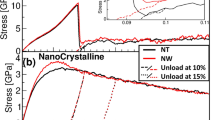Abstract
Details of how atomic structure responds to strain are essential for building a deeper picture of mechanics in nanomaterials. Here, we provide the first experimental evidence of atomic displacements associated with shear strain in single-walled carbon nanotubes (SWNTs) by direct imaging using aberration-corrected transmission electron microscopy. The atomic structure of a zig-zag SWNT is resolved with unprecedented accuracy and the strain induced by bending is mapped in two dimensions. We show the existence of a dominant non-uniform shear strain that varies along the SWNT axis. The direction of shear is opposite to what would be expected from a simple force applied perpendicular to the axis to produce the bending. This highlights the complex atomistic strain behaviour of beam-bending mechanics in highly anisotropic SWNTs.
This is a preview of subscription content, access via your institution
Access options
Subscribe to this journal
Receive 12 print issues and online access
$259.00 per year
only $21.58 per issue
Buy this article
- Purchase on Springer Link
- Instant access to full article PDF
Prices may be subject to local taxes which are calculated during checkout




Similar content being viewed by others
References
O’Connell, A. D. et al. Quantum ground state and single-phonon control of a mechanical resonator. Nature 464, 697–703 (2010).
Salvetat, J-P. et al. Elastic and shear moduli of single-walled carbon nanotube ropes. Phys. Rev. Lett. 82, 944–947 (1999).
Sazanova, V. et al. A tunable carbon nanotube electromechanical oscillator. Nature 431, 284–287 (2004).
Wei, X-L., Liu, Y., Chen, Q., Wang, M-S. & Peng, L-M. The very low shear modulus of multi-walled carbon nanotubes determined simultaneously with the axial Young’s modulus via in situ experiments. Adv. Funct. Mater. 18, 1555–1562 (2008).
Hsu, J-C., Chang, R-P. & Chang, W-J. Resonance frequency of chiral single-walled carbon nanotubes using Timoshenko beam theory. Phys. Lett. A 372, 2757–2759 (2008).
Lu, P., Lee, H. P., Lu, C. & Zhang, P. Q. Application of nonlocal beam models for carbon nanotubes. Int. J. Solids Struct. 44, 5289–5300 (2007).
Nardelli, M. B., Yakobson, B. I. & Bernholc, J. Brittle and ductile behavior in carbon nanotubes. Phys. Rev. Lett. 81, 4656–4659 (1998).
Yakobson, B. I., Brabec, C. J. & Bernholc, J. Nanomechanics of carbon tubes: Instabilities beyond linear response. Phys. Rev. Lett. 76, 2511–2514 (1996).
Falvo, M. R. et al. Bending and buckling of carbon nanotubes under large strain. Nature 389, 582–584 (1997).
Srivastava, D., Menon, M. & Kyeongjae, C. Nanoplasticity of single-wall carbon nanotubes under uniaxial compression. Phys. Rev. Lett. 83, 2973–2976 (1999).
Hashimoto, A., Suenaga, K., Gloter, A., Urita, K. & Iijima, S. Direct evidence for atomic defects in graphene layers. Nature 430, 870–873 (2004).
Meyer, J. C. et al. Direct imaging of lattice atoms and topological defects in graphene membranes. Nano Lett. 8, 3582–3586 (2008).
Suenaga, K. et al. Imaging active topological defects in carbon nanotubes. Nature Nano 2, 358–360 (2007).
Warner, J. H. et al. Structural transformations in graphene studied with high spatial and temporal resolution. Nature Nano 4, 500–504 (2009).
Gomez-Navarro, C. et al. Atomic structure of reduced graphene oxide. Nano Lett. 10, 1144–1148 (2010).
Warner, J. H. et al. Investigating the diameter dependent stability of single-walled carbon nanotubes. ACS Nano 3, 1557–1563 (2009).
Warner, J. H., Rummeli, M. H., Gemming, T., Buchner, B. & Briggs, G. A. D. Direct imaging of rotational stacking faults in few layer graphene. Nano Lett. 9, 102–106 (2009).
Girit, C. O. et al. Graphene at the edge: stability and dynamics. Science 323, 1705–1708 (2009).
Warner, J. H. et al. One dimensional confined motion of single metal atoms inside double-walled carbon nanotubes. Phys. Rev. Lett. 102, 195504 (2009).
Chuvilin, A. et al. Observations of chemical reactions at the atomic scale: dynamics of metal mediated fullerene coalescence and nanotube rupture. Angew. Chem. Int. Ed. 48, 193–196 (2009).
Sato, Y. et al. Chiral-angle distribution for separated single-walled carbon nanotubes. Nano Lett. 8, 3151–3154 (2008).
Zhu, H., Suenaga, K., Hashimoto, A., Urita, K. & Iijima, S. Structural identification of single and double-walled carbon nanotubes by high resolution transmission electron microscopy. Chem. Phys. Lett. 412, 116–120 (2005).
Iijima, S., Brabec, C., Maiti, A. & Bernholc, J. Structural flexibility of carbon nanotubes. J. Chem. Phys. 104, 2089–2092 (1996).
Urban, K. W. Studying atomic structures by aberration-corrected transmission electron microscopy. Science 321, 506–510 (2008).
Jia, C. L. & Urban, K. Atomic-scale study of electric dipoles near charged and uncharged domain walls in ferroelectric films. Nature Mater. 7, 57–61 (2008).
Hytch, M. J., Putaux, J-L. & Penisson, J-M. Measurement of the displacement field of dislocations to 0.03 Å by electron microscopy. Nature 423, 270–273 (2003).
Willems, B., Nistor, L. C., Ghica, C. & Van Tendeloo, G. Strain mapping around dislocations in diamond and cBN. Phys. Status Solidi A 202, 2224–2228 (2005).
Hytch, M. J., Snoeck, E. & Kilaas, Quantitative measurement of displacement and strain field from HREM micrographs. Ultramicroscopy 74, 131–146 (1998).
Galindo, P. L. et al. The peak pairs algorithm for strain mapping from HRTEM images. Ultramicroscopy 107, 1186–1193 (2007).
Rosenauer, A., Fischer, U., Gerthsen, D. & Förster, A. Composition evaluations of InxGa1−xAs Stranski–Krastanow-island structures by strain state analysis. Appl. Phys. Lett. 71, 3868–3871 (1997).
Auld, B. A. Acoustic Fields and Waves in Solids Vol. 1 (Wiley, 1973).
Huang, M., Pascal, T. A., Kim, H., Goddard, W. A. III & Greer, J. R. Electronic-mechanical coupling in graphene from in situ nanoindentation experiments and multiscale atomistic simulations. Nano Lett. 11, 1241–1246 (2011).
Bichoutskaia, E. Modelling interwall interactions in carbon nanotubes: Fundamentals and device applications. Phil. Trans. R. Soc. A 365, 2893–2906 (2007).
Acknowledgements
J.H.W. thanks the Royal Society and the Glasstone Fund for support. We thank Meijo Nanocarbon for their generous supply of SWNTs.
Author information
Authors and Affiliations
Contributions
J.H.W. designed and conducted the experiments, analysed the results and wrote the paper. N.P.Y. and A.I.K. assisted with the HRTEM. G.A.D.B. assisted with the analysis of the results.
Corresponding author
Ethics declarations
Competing interests
The authors declare no competing financial interests.
Supplementary information
Supplementary Information
Supplementary Information (PDF 3277 kb)
Rights and permissions
About this article
Cite this article
Warner, J., Young, N., Kirkland, A. et al. Resolving strain in carbon nanotubes at the atomic level. Nature Mater 10, 958–962 (2011). https://doi.org/10.1038/nmat3125
Received:
Accepted:
Published:
Issue Date:
DOI: https://doi.org/10.1038/nmat3125
This article is cited by
-
Pseudo-break imaging of carbon nanotubes for determining elastic bending energies
Nano Research (2023)
-
Direct assessment of confinement effect in zeolite-encapsulated subnanometric metal species
Nature Communications (2022)
-
Static moiré patterns in moving grids
Scientific Reports (2020)
-
Characterization of Optimal Carbon Nanotubes Under Stretching and Validation of the Cauchy–Born Rule
Archive for Rational Mechanics and Analysis (2019)
-
Towards clinically translatable in vivo nanodiagnostics
Nature Reviews Materials (2017)



